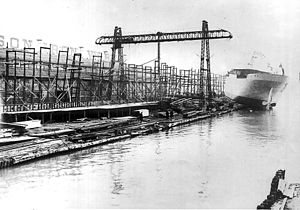Polson slip: Difference between revisions
George Swan (talk | contribs) (more details) |
George Swan (talk | contribs) (copy editing) |
||
| Line 26: | Line 26: | ||
| quote = Boundaries: The Keating Channel to the north, Toronto's Inner Harbour to the West, Polson Slip to the south and the Don Roadway to the east. | | quote = Boundaries: The Keating Channel to the north, Toronto's Inner Harbour to the West, Polson Slip to the south and the Don Roadway to the east. | ||
}} | }} | ||
</ref> | |||
<ref name=PolsonEmpress> | <ref name=PolsonEmpress> | ||
Revision as of 19:04, 2 January 2024
The Polson slip is an east-west oriented slip in Toronto's Portlands. The slip is named in honour of the Polson Iron Works, a shipyard where many historic Canadian vessels were constructed.[1] The slip is approximately 500 m (1640.42 ft) long, and runs parallel to Polson Street.
On the south shore of the slip are cement silos operated by Lafarge Cement.[1] On the north shore there is a yard for maintaining and storing recreational vessels. Excursion vessels, which provide harbour tours, or host party-goers on floating parties, moore in the slip.[2] Occasionally lake freighters moore in the slip. South of the mouth of the slip there is a short boardwalk, that provides the only place where pedestrians can stroll the eastern shore of Toronto harbour.[3][4]
According to Mike Filey, a columnist and author, who writes about Toronto's history, the area around the slip was under consideration as a possible venue for the Athlete's Village, if Toronto had won the right to host the 2008 Olympic Games.[1]
In 2019 Toronto started a long-term project to redevelop the Portlands, said to the largest parcel of undeveloped land located close to the downtown of a North American city. The first step was to relandscape the mouth of the Don River, which was canalized at the turn of the 19th Century, carving out an island, Villiers Island.[5] The relandscaping will fork the Don, with a southern mouth emerging into the Polson slip. The norther shore of the slip will be converted to parkland.
See also
References
- ↑ 1.0 1.1 1.2 Mike Filey. Discover & Explore Toronto's Waterfront: A Walker's, Jogger's, Cyclist's, Boater's Guide to Toronto's Lakeside Sites and History, Dundurn Press, 1998, pp. 103,104. Retrieved on 2014-01-02. “The present name commemorates a former harbour industry, the Polson Iron WOrks Company, which was established in 1883 at the foot of Princess Street on the old waterfront by William Polson.”
- ↑ Empress Of Canada, Hype1. Retrieved on 2014-01-02.
- ↑ Derek Flack. The top views of Toronto, Blog TO, 2010-07-28. Retrieved on 2014-01-02. “A quick perusal of the blogTO Flickr pool reveals that Polson St. is far and away the most popular location photographers select to shoot the Toronto skyline.”
- ↑ Secret 164: Polson Street, the view that launched a thousand postcards, Canada's Daily Secret. Retrieved on 2014-01-02. “The very view we were looking over has been, he said, immortalised on almost any city memorabilia we'd ever seen, so no wonder it was ingrained in our subconscious! You don't need to be a photographer to enjoy this lakeside lookout: bring a folding chair along, if you can, to sit comfortably while resting your eyes on the reassuringly recognisable panorama.”
- ↑ Villiers Island. Waterfront Toronto. “Boundaries: The Keating Channel to the north, Toronto's Inner Harbour to the West, Polson Slip to the south and the Don Roadway to the east.”
